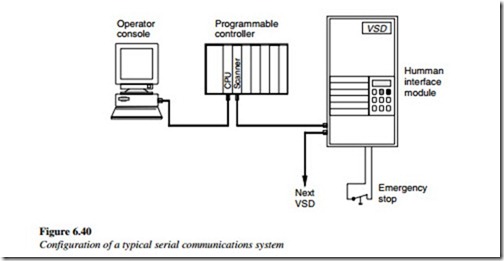Control wiring for VSDS
VSD may be controlled ‘locally’ by means of manual pushbuttons, switches, and potentiometers mounted on the front of the converter. For simple, manually controlled operations, these local controls are all that is required to operate the VSD.
In most industrial applications, it is not practical to control the VSD from the position where the VSD is located. VSDs are usually installed inside MCCs, which are located in switch rooms, usually close to the power supply transformer, but not necessarily, close to where the operator is controlling the process.
Remote operation of VSD
Almost all VSDs have terminals that permit ‘Remote Control’ from a location close to the operator. VSDs have terminals for the following controls:
• DI, such as remote Start, Stop, Reverse, Jog, etc., which are usually implemented by
(a) Remote pushbuttons in a manually controlled system
(b) DO of a process controller in an automated system.
• Digital status outputs, such as indication of Running, Stopped, At Speed, Faulted, etc., which are usually implemented by
(a) Remote alarm and indication lamps in a manually controlled system
(b) DI to a process controller in an automated system.
• AI, such as remote Speed Reference, Torque Reference, etc., which are usually implemented by (a) Remote potentiometer (10 kΩ pot) in a manually controlled system
(b) Analog outputs, such as remote Speed Indication, Current Indication, etc., which are usually implemented by remote display meters (0–10 V) in a manually controlled system
(c) AI to a process controller in an automated system, usually using a 4–20 mA signal carried on a screened twisted pair cable.
Manual and automated control systems have operated very effectively for many years with this type of ‘hard-wired’ control system. The main disadvantage of this system is:
• All DIs and DOs require one wire per function and a common connection
• All AIs and AOs require two wires per function and a shield connection.
Hard-wired connections to PLC control systems
With the introduction of automated control systems using, PLCs and distributed control systems (DCS), the ‘hard-wired’ control connections have been extended, with input/output (I/O) modules replacing the manual controls.
Control systems have grown in complexity and the amount of information required from field sensors has expanded the number of conductors required to implement the
automated control system. This affects both the cost and the complexity.
As more field devices become integrated into the overall control system, there arises the problem of complex cabling.
A hard-wired interface between a VSD and a PLC would typically require about
15 conductors as follows:
• Five conductors for controls such as Start, Stop, Enable, Reverse, etc.
• Four conductors for status/alarms, such as Running, Faulted, at Speed, etc.
• Two or three conductors for analog control, such as Speed set point
• Four conductors for analog status, such as Speed indication, Current indication.
If there are several VSDs in the overall system, the number of wires is multiplied by the number of VSDs in the system.
Serial communications with PLC control systems
‘Serial Communications’ helps overcome these problems and allows complex field instruments and VSD systems to be linked together, into an overall automated control system with minimum cabling.
Microprocessors-based digital control devices, sometimes called ‘Smart’ devices, are increasingly being used in modern factory automation and industrial process control
systems. Several ‘smart’ devices can be ‘multi-dropped’ or ‘daisy-chained’ on one pair of wires and integrated into the overall automated control system. Control and status information can be transferred serially between the process controller and the VSDs located in the field. Parameter settings can also be adjusted remotely from a central point (Figure 6.40).
